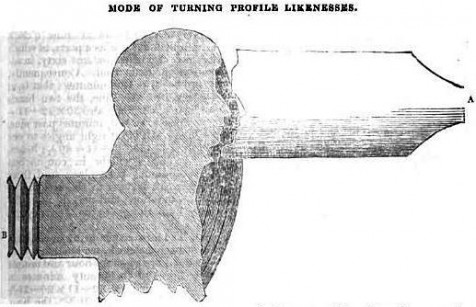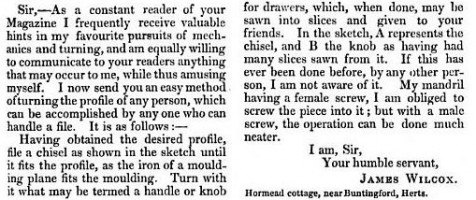Those crazy Victorian inventors. What can you do with them? Whenever I research a history project, some totally unconnected but wonderful distraction like this shows up and wants sharing.
Maybe that’s how inventor James Wilcox thought about his ‘profile likeness’ doorknob keepsake idea from the Victorian era, reported in an 1838 edition of (take a deep breath) the Mechanics’ Magazine, Museum, Register, Journal and Gazette: one of the many popular journals at the time disseminating a veritable gush of 19th century science and engineering.
At first glance I thought this was about profiling a door knob and sticking it back on the door; but that wouldn’t really work – would it. No, Wilcox’s breakthrough technology involves filing the profile of your head into a steel tool, and using it to turn a likeness into an old wooden doorknob. Cutting the thus-profiled piece into slices gives you a whole bunch of keepsakes for handing out to friends and acquaintances. Inspired!
Okay, I’m taking the Mickey a bit because it’s such an off-the-wall thing, not to say off-the-door thing, to spend your time on. But in all seriousness, there seem to have been a lot of men (at least mainly men were visible) like Wilcox around, who, variously tucked away in workshops, cottages, and garden sheds, had the will and wherewithal to have a go at the various engineering challenges of the day. And even if some ideas were silly and others came to nought, ordinary folk still felt they had the right and ability to contribute – although with increasing complexity and specialisation that was becoming ever harder; it’s almost impossible today.
Hey, I like Wilcox’s idea – a kind of wooden business card or Carte de Visite as the Victorians would have it. It’s not like you’d forget a guy who slipped you a slice of his door knob.
I also like Wilcox’s self-effacing humility, where after he says “If this has ever been done before, by any other person, I am not aware of it” he goes on to concede there’s still room for improvement – if only that messy screwed piece at the back was done away with. Ah, the compromises one has to make for rapid prototyping, or as Wilcox explains in value-added detail right to the end “My mandrill having a female screw, I am obliged to screw the piece into it; but with a male screw, the operation can be done much neater.”
There you go. A little whiff of the Great in Great Britain :-P.

